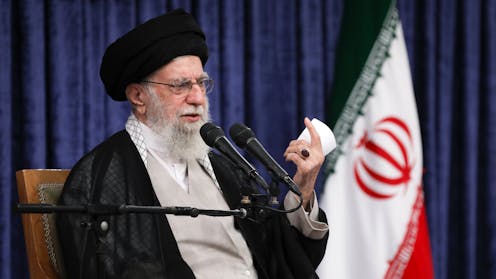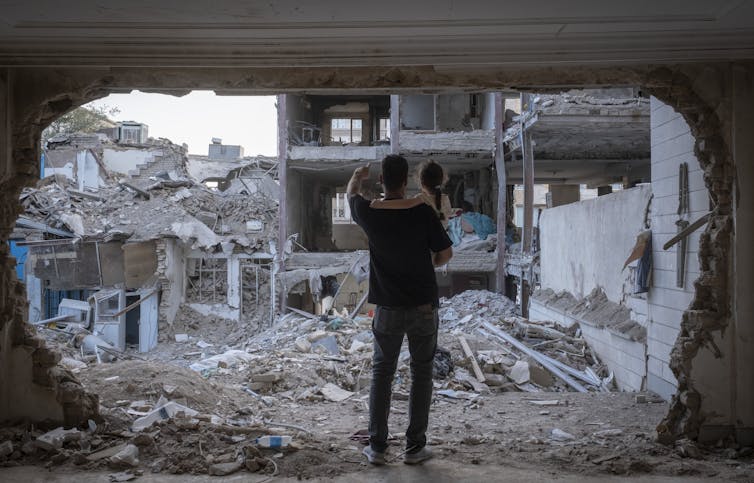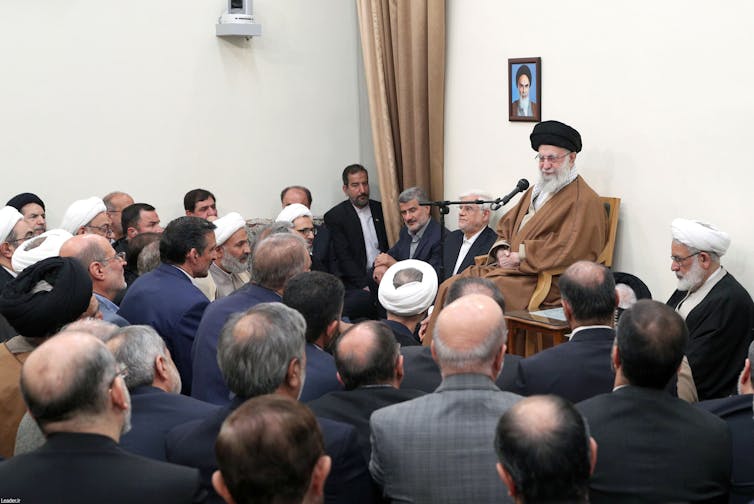Where next for Khamenei? After war, Iran’s supreme leader is faced with difficult choices
- Written by Shirvin Zeinalzadeh, Graduate Teaching Associate, School of Politics and Global Studies, Arizona State University
 Iranian Supreme Leader Ayatollah Ali Khamenei makes a speech in Tehran, Iran, on July 16, 2025. Photo by Iranian Leader Press Office/Anadolu via Getty Images
Iranian Supreme Leader Ayatollah Ali Khamenei makes a speech in Tehran, Iran, on July 16, 2025. Photo by Iranian Leader Press Office/Anadolu via Getty ImagesIn the weeks since Israel’s expansive 12-day war, Iran’s Supreme Leader Ayatollah Ali Khamenei has rarely been seen in public.
That absence has inevitably led to speculation over the 86-year-old’s health. But it also left many Middle East observers wondering about the future direction of the republic, and how its leadership will respond to possibly Iran’s biggest challenges since the Iran-Iraq war of the 1980s.
The attacks by Israel, and later the U.S., struck hundreds of targets across the country and resulted in the deaths of over 1,000 people, including many of Iran’s top military commanders and nuclear scientists.
But it was all the more stark, for those in Tehran, for how it caught the Islamic Republic by surprise. Indeed, Iran had been engaged in good-faith diplomatic talks with the United States.
It was, in the words of Hassan Rouhani, the former president and potential successor to Khamenei, a “wake-up call to correct our course and rebuild the foundations of governance.”
But will the leader heed that call? As a scholar of Iranian and Middle Eastern political affairs, I believe the conflict has provided the opportunity for the Iranian leadership to reestablish itself with some notion of regeneration that could appease both the traditional conservatives as well as those seeking reform with the domestic status quo.
The ayatollah’s greatest dilemma
As Iran civilian and military targets were being hit by repeated Israeli airstrikes, and intelligence operations were picking off senior government and military officials, Khamenei was reportedly commanding from a safe bunker.
Already cognizant of the potential threat to his security before the latest conflict, the supreme leader is known to have considered contingency succession plans and seemingly named potential successors should he perish. These names were not publicly released but were rumored not to have included his son, Mojtaba Khamenei, but is speculated to have included some of his closest allies.
Being cloistered from the conflict and considering his potential imminent demise underscored just how under the spotlight Khamenei’s leadership has become. One of the world’s longest-serving leaders, and once seen as the unifying axis of the Islamic Republic as well as inheritor of the legacy of the Iranian Revolution’s founding father, Ayatollah Khomeini, the supreme leader is now facing rare scrutiny from various quarters.
 An Iranian man carries a young girl and points at a destroyed residential building targeted amid the Iran-Israel 12-day war in Tehran, Iran, on July 21, 2025.Photo by Morteza Nikoubazl/NurPhoto via Getty Images
An Iranian man carries a young girl and points at a destroyed residential building targeted amid the Iran-Israel 12-day war in Tehran, Iran, on July 21, 2025.Photo by Morteza Nikoubazl/NurPhoto via Getty ImagesWhile Khamenei still earned official praise from elements of his coalition over the handling of the war, critics have questioned his strategic handling of the conflict with Israel, arguing that the confrontation exposed Iran’s military vulnerabilities without delivering meaningful gains – something Iran has contested vehemently in its own evaluation of the conflict.
Meanwhile, some point to his advanced age and long-standing resistance to change as obstacles to the country’s political and economic revival, with even his closest adviser, Ali Akbar Velayati, suggesting now is the time for reform.
Reform or redouble?
Given this confluence of negative events and perceptions, Khamenei now faces a choice. He still commands deep loyalty among conservative domestic audiences and the security establishment, yet his government’s standing beyond that is receiving more critique than ever.
At the same time, the postwar landscape has created an opening for reform that could shore up the Islamic Republic’s future, calm social pressures and reopen doors to diplomacy and investment.
One path for Khamanei would be to remain as supreme leader but gradually delegate, signaling controlled change from within. Another, more dramatic option would echo Pope Benedict XVI’s precedent: a formal abdication that preserves his spiritual and symbolic standing, allowing him to maintain a ‘Leader Emeritus’ title, while transferring day-to-day authority to a successor empowered to slowly introduce incremental reform without publicly diminishing him. Such a staged handover could let the system adapt, give younger elites political space and allow policy shifts to proceed without the notion of losing credibility.
But there also remains the reality that Khamenei’s loyal conservative followers command a strong pull with domestic audiences. And those factions, especially after the latest conflict, will be less inclined to consider reform and far more interested in cracking down on potential information leaks that led Israel to conduct such precise operations against military elites in the first place.
Yet given the position of the government, reform is inevitably on the agenda again. And some of the reforms being quietly discussed include loosening internet restrictions, particularly on popular social media platforms widely used by Iran’s large and youthful population.
Access to digital spaces has become not just a cultural and economic issue but a marker of generational culture. In the wake of the 2022 death of Mahsa Amini, whose detention by morality police and subsequent death led to widespread protests, Iran’s leaders have faced calls to revise the government’s strict morality laws. If the government made reforms to that end, which have already been unofficially and anecdotally reported in places, it could help ease tensions with women and younger Iranians without fundamentally challenging the system’s foundations.
On the international front, Iran has already begun to recalibrate its foreign policy, as reflected in its accession to the BRICS group of nations in 2024. This move suggests a desire to become less isolationist and to engage more actively on the global stage. Further steps could include seeking membership in other international institutions and organizations in exchange for commitments on regional and global issues, along with enhanced cooperation with nuclear watchdogs and regulatory bodies.
If successful, that might unlock long-stalled investment opportunities and trade partnerships, helping to revive an economy hit by years of U.S.-imposed sanctions and isolation. Each of these steps, while modest in isolation, could signal a broader shift – not in a full overnight transformation, but a cautious adaptation that shows a willingness to adapt.
The million-dollar question
This is all related to the most pressing international question of Iran’s nuclear program, which remains unresolved despite the recent conflict and reported severe damage from U.S. bunker-busting strikes. Tehran continues to insist that its nuclear ambitions are purely peaceful and civilian in nature and would be loathe to abandon the program.
For the Islamic Republic, the program is more than a strategic deterrent; it stands as a marker of national pride and technological advancement. Whether under the current supreme leader or a future successor, the issue will remain central to the identity and long-term vision of the state.
 Iran’s Supreme Leader Ayatollah Ali Khamenei holds a meeting with senior officials at his residence in Tehran, Iran, on April 15, 2025.Photo by Iranian Leader Press Office/Handout/Anadolu via Getty Images
Iran’s Supreme Leader Ayatollah Ali Khamenei holds a meeting with senior officials at his residence in Tehran, Iran, on April 15, 2025.Photo by Iranian Leader Press Office/Handout/Anadolu via Getty ImagesDespite threats to pull out of the Nuclear Non-Proliferation Treaty during the recent conflict with Israel, Iran remains a signatory and maintains that its nuclear program operates within the bounds of international law.
Yet any move toward greater transparency or cooperation must be weighed against past experience. The 2015 nuclear agreement, once hailed as a diplomatic breakthrough, ultimately collapsed after the United States unilaterally withdrew and reimposed economic sanctions on Tehran during President Donald Trump’s first term. In the aftermath of the Iran deal’s fall, Iran was targeted by a series of covert operations and military strikes widely attributed to Israel or even – in the case of assassinated general Qassem Soleimani – the U.S. These events have reinforced skepticism within Tehran’s leadership about the reliability of Western commitments and the costs of compromise.
As such, while a more open and cooperative posture could in theory lead to eased sanctions, renewed trade and a path to international legitimacy, it also risks undermining Iran’s self-styled mantle of resistance to American and Israel regional policy. For any reformist shift to gain traction, it would have to reconcile Iran’s desire for economic recovery with the imperative of preserving ideological credibility at home and projecting resilience abroad.
All of this will weigh on Khamenei, who has overall say in all foreign and domestic policy matters. Choosing to reform while still alive and in power could allow him to shape his legacy on his own terms, preserving the core of the Islamic Revolution while gently steering the country toward necessary change.
In doing so, he may also find a rare balance between tradition and modernity that speaks to both loyal conservatives and a generation hungry for reform. The war, ironically, may have presented Khamenei with the opportunity to thread that needle. The big question now is will he.
Shirvin Zeinalzadeh does not work for, consult, own shares in or receive funding from any company or organization that would benefit from this article, and has disclosed no relevant affiliations beyond their academic appointment.
Authors: Shirvin Zeinalzadeh, Graduate Teaching Associate, School of Politics and Global Studies, Arizona State University

